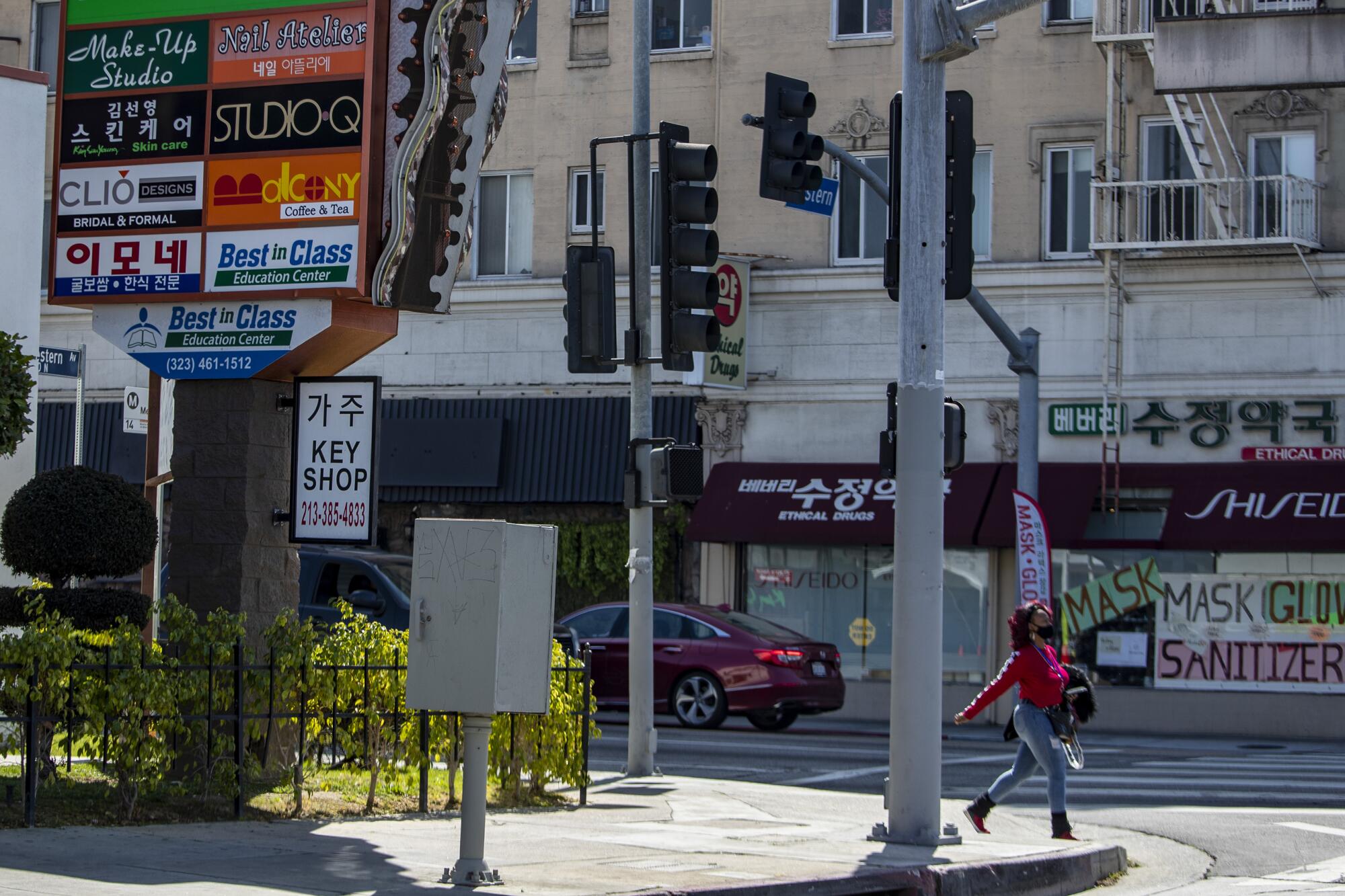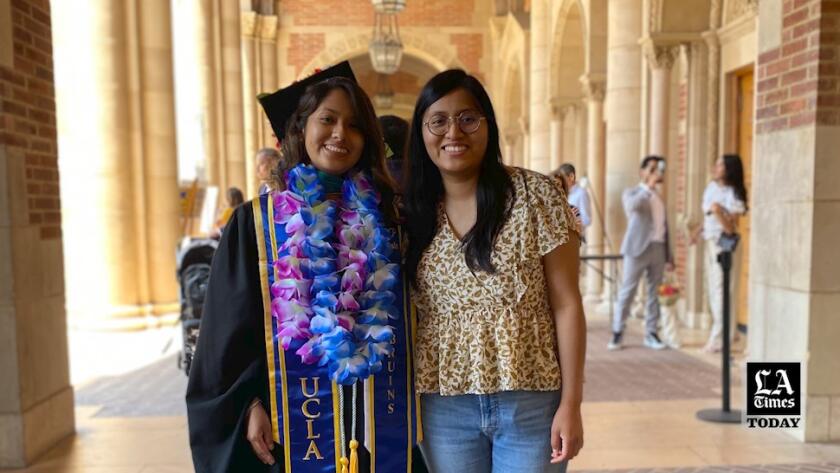
- Share via
My sister and I have called Westlake and Koreatown home our entire lives, but rising rent priced us out of our own community. Southern California’s high costs of living and limited homeowner support programs made it nearly impossible to find a better housing situation for our family.
Growing up in a predominately low-income immigrant community, we assumed living in an overcrowded apartment was the norm.
For more than 25 years, our family of four lived in a rent-controlled, cramped 450-square-foot studio with a walk-in closet and tiny bathroom. We converted the walk-in closet into a bedroom and our parents slept in a twin-sized bed right outside the kitchen. Our apartment was old, moldy and infested with roaches and hadn’t been renovated since we moved in — hence the rent being cheaper than the market rate for L.A. County.
As we got older, we realized that we had lived in two scenarios identified by health and other organizations as threatening housing instability: living doubled up, meaning when adults beyond a head of household and partner have to share a home, and then living crowded, where the number of residents exceeds the capacity of the space, often leading to poor physical and mental health. An L.A. Times analysis published last year found that Los Angeles was the most overcrowded city in America as of 2020.
We want to hear how you navigated the costly housing market in L.A. Tell us your story.
Right before COVID-19 hit, we held unstable minimum wage, temporary and stipend-based positions and struggled to pay rent. Then during the pandemic, we found it increasingly difficult to complete remote work and online school in our crowded living situation. As COVID cases subsided, we got our first full-time jobs and considered moving to a bigger place. But the cheapest apartments we looked at were at least half of our combined income.
We were torn. On the one hand, we had stayed far too long in an uncomfortable living situation. Seeing apartment complexes in our neighborhood be demolished and replaced by luxury high-rises also made us fear that it was just a matter of time before we would be evicted. On the other hand, we could not justify spending so much on rent, especially since a rule of thumb is to spend no more than a third of your income on housing. And since we had both been laid off during the pandemic, we feared becoming unemployed again in the future.
After crunching the numbers, we decided to pursue an option we previously considered out of reach: saving up to buy a home. Given the rising local costs of rent, in the long run we’d be better off buying. We also wanted to repay our parents for all the sacrifices they made to ensure we had a roof over our heads, and for their love and support. So we continued to live in our crowded apartment while aggressively saving up for a down payment and for an emergency fund because we feared going back to job instability.
As first-generation Latina home buyers, we did our best to navigate the process by combing through programs for buyers like us. Those didn’t end up helping.
Homelessness among Latinos has shot up in Los Angeles County while other demographic groups have seen a decline over the last two years.
The first program we tried was Bank of America’s Community Affordable Loan Solution, which among other benefits provides up to $15,000 in down payment assistance for first-time home buyers in L.A. and a handful of other cities to purchase in a community that is predominantly Black, Latino or both. But we were told we were ineligible for the program because our combined annual income just exceeded the maximum limit of $136,650. At the same time, we are considered low-income in L.A. County, suggesting the program’s cutoff is too strict to help everyone who needs it.
Next we considered applying for the California Dream for All Shared Appreciation Loan program, which provides a loan worth up to 20% of a home’s sale price. However, the program also requires borrowers to pay 20% of the home’s increase in value once it’s sold on top of paying back the original loan. We worried that borrowing this amount would ultimately hurt us by taking away a portion of our future equity. Then that consideration turned out to be moot: The program ran out of funds two weeks after launching, before we could even complete the preapproval process.
We also found significant problems with the equity of these programs. Although the Community Affordable Loan Solution is meant to support Black and Latino communities, which have historically low rates of homeownership, it does not require individuals to identify as Black or Latino to qualify. Similarly, though the California Dream for All program was meant in part to reduce racial wealth gaps in the state, CalMatters found that 65% of the initial recipients were white. Only 34% of beneficiaries identified as Latino and just 4% identified as Black. California’s longtime affirmative action ban restricts the agency’s ability to target funds for people of color.
Fortunately, we finally found a home for our family in a different part of Los Angeles. Looking back, we’re grateful that our relatively low-cost living situation allowed us to save. Even so, families should not have to live in cramped, small living spaces to afford rent — and tolerating these conditions should not be the only option renters have when trying to save up for a down payment.
Getting people off the streets and into temporary shelter isn’t the only answer to L.A.’s homelessness problem. We need more permanent housing solutions.
Moreover, since we were unsuccessful with first-time buyer programs, we felt compelled to make the risky decision to deplete our emergency fund to place a 3% down payment. Although that enabled us to buy our home, we aren’t sure what the future holds for us. We can’t say it was an easy process.
Federal and state officials should evaluate how first-time homebuyer programs are designed, rolled out and made available particularly to Black and Latino applicants. Providers should consider offering assistance on a sliding scale based on income level rather than using relatively low cutoffs. Other alternatives might be to create down-payment assistance grants rather than loans, or loans that do not accrue interest until a home buyer reaches a small portion of equity (such as 3%). Such approaches may help people get into homes sooner and obtain equity faster.
We hope to see better options for all low-income renters. Homeownership should not be this inaccessible, especially for people who are seeking to become the first in their families to buy a home and build generational wealth.
Jennifer Nazario is a systems administrator at a network of college-preparatory schools and a first-generation college graduate with a master’s degree in economics. Paula Nazario is an assistant director at UCLA and the first person in her family to go to college. She has a master’s degree in public policy.
- Share via
Watch L.A. Times Today at 7 p.m. on Spectrum News 1 on Channel 1 or live stream on the Spectrum News App. Palos Verdes Peninsula and Orange County viewers can watch on Cox Systems on channel 99.
More to Read
A cure for the common opinion
Get thought-provoking perspectives with our weekly newsletter.
You may occasionally receive promotional content from the Los Angeles Times.













